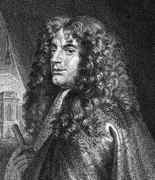Person: Cassini, Giovanni Domenico

Giovanni Cassini (Cassini I) was an Italian mathematician and astronomer who studied the curve which is the locus of a point the product of whose distances from two fixed foci is constant.
Mathematical Profile (Excerpt):
- He was given the name Giovanni Domenico by his parents, Jacopo Cassini and Julia Crovesi, after his birth in Italy.
- However he also used the name Gian Domenico Cassini, and after he moved to France, he changed his name to the French version of Jean-Dominique Cassini.
- After spending two years being educated at Vallebone, Cassini entered the Jesuit College at Genoa where he studied under Casselli.
- In 1644 the Marquis Cornelio Malvasia, who was a senator from Bologna with a great interest in astrology, invited Cassini to Bologna.
- From 1648 Cassini observed at the Panzano Observatory with instruments which he had purchased with financial resources from the Marquis Malvasia.
- This was an important time for Cassini who learnt much from the outstanding Jesuit scientists Giovanni Battista Riccioli and Francesco Maria Grimaldi (who later discovered diffraction).
- In 1650, Cassini became professor of mathematics and astronomy at the University of Bologna, filling the chair which had been vacant since the death of Cavalieri at the end of November 1647.
- Cassini observed a comet in 1652-3 and he published an account of his observations which he dedicated to the Duke of Modena.
- From the work we can see that at this time Cassini believed in an Earth centred solar system, with comets beyond Saturn but originating from the Earth.
- One of Cassini's predecessor's as professor of mathematics and astronomy at Bologna had been Egnatio Danti who had been appointed in 1576.
- His calculations were precise; the construction succeeded perfectly; and its success made Cassini a brilliant reputation.
- The Pope asked Cassini to take Holy Orders for he wished to see him permanently working for him.
- However, Cassini preferred to keep his post as professor of mathematics and astronomy at Bologna where he taught when not undertaking Papal duties.
- Beginning in 1664 Cassini was able to observe with new powerful telescopes made by the excellent lens maker Giuseppe Campani of Rome.
- With these instruments Cassini made a series of new discoveries.
- However, Cassini was too traditional in his views to accept his own idea, and he soon rejected it and looked for other explanation for the discrepancy.
- It is rather ironical that it was Cassini's data that was used by Rømer in calculating the speed of light seven years later.
- Cassini's brilliant discoveries gave him an international reputation and led to him being invited to Paris by Louis XIV in 1668.
- The construction of the Paris Observatory had just begun and Cassini was offered a generous salary, free accommodation, and a good travel allowance to oversee the project.
- However Cassini was immediately involved in the work of the Académie des Sciences although at this stage he made little attempt to settle down and improve his French as he still fully intended a quick return to his duties in Italy.
- After he became head of the Paris Observatory in 1671, he soon changed his views on returning to Italy and became a French citizen two years later, changing his name to Jean-Dominique Cassini.
- At the Paris Observatory Cassini continued to make revolutionary discoveries, as he had done in Italy, using a telescope he had brought with him.
- He discovered the gap in the ring system of Saturn now known as the Cassini division in 1675.
- Cassini's tables of Jupiter's moons were used to determine longitudes by providing a universal time with which to compare the local time at various positions on the Earth.
- While French expeditions measured the longitudes of numerous places, Cassini remained in Paris coordinating their data and making his own measurements.
- In 1672 Jean Richer made measurements of Mars from Cayenne, French Guyana, while Jean Picard and Cassini made measurements in Paris.
- This supported theoretical proposals by Newton and Huygens, but Cassini did not accept Jean Richer's explanation.
- In order to determine the shape of the Earth, Cassini proposed measuring an arc of the meridian from the north of France to the south.
- The project was begun in 1683 with Cassini making measurements from Paris towards the south, while Philippe de La Hire began making measurements north from Paris.
- The project was cancelled for financial reasons in 1684 when Cassini had reached Bourges, which is almost exactly in the centre of France.
- In 1695 Cassini travelled in Italy.
- In 1680 he studied the Cassinian curve which is the locus of a point the product of whose distances from two fixed foci is constant.
- The lemniscate of Jacob Bernoulli is a member of the Cassinian curves but this was not realised for 100 years.
- Cassini's health began to deteriorate, in particular his eyesight became poor so that by 1711 he was nearly completely blind.
- Although Cassini's control did restrict the Observatory's studies and although he did fight against most of the new theories, his behaviour does not seem as uniformly tyrannical and baleful as Delambre described it.
Born 8 June 1625, Perinaldo, Republic of Genoa (now Italy). Died 14 September 1712, Paris, France.
View full biography at MacTutor
Tags relevant for this person:
Astronomy, Geography, Origin Italy, Physics
Thank you to the contributors under CC BY-SA 4.0! 

- Github:
-

- non-Github:
- @J-J-O'Connor
- @E-F-Robertson
References
Adapted from other CC BY-SA 4.0 Sources:
- O’Connor, John J; Robertson, Edmund F: MacTutor History of Mathematics Archive
